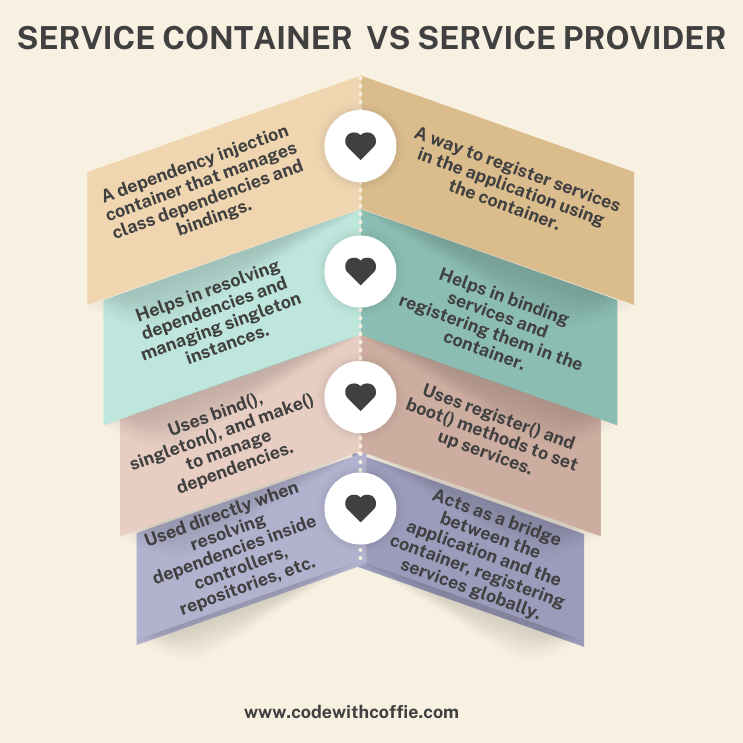In modern application development, especially in frameworks like Laravel, two terms often pop up: Service Provider and Service Container. Both play critical roles in managing dependencies and organizing code, but they serve different purposes. In this blog post, we’ll dive deep into what they are, how they work, and why they matter.
What is a Service Container?
A Service Container is a powerful tool used to manage class dependencies and perform dependency injection. Think of it as a dependency injection container that holds all the services (classes, objects, functions) your application needs.
Key Features of a Service Container:
- Dependen****cy Resolution: Automatically injects required dependencies when a class is instantiated.
- Centralized Management: Manages all bindings and instances in one place.
- Flexible Binding: Allows binding interfaces to concrete classes, singletons, or closures.
Example:
// Binding an interface to a concrete class
$app->bind('App\Contracts\PaymentGateway', 'App\Services\StripePaymentGateway');
// Resolving the dependency
$paymentGateway = $app->make('App\Contracts\PaymentGateway');In this example, the Service Container knows how to provide an instance of StripePaymentGateway whenever the PaymentGateway interface is requested.
What is a Service Provider?
A Service Provider is a class responsible for registering bindings, listeners, middleware, and even routes with the application. It’s the central place to configure services in the application.
Key Responsibilities of a Service Provider:
- Register Services: Define how services are bound to the container.
- Boot Services: Execute code after all services are registered.
- Organize Code: Keeps the registration logic clean and maintainable.
Example:
namespace App\Providers;
use Illuminate\Support\ServiceProvider;
use App\Services\StripePaymentGateway;
class PaymentServiceProvider extends ServiceProvider
{
public function register()
{
$this->app->bind('App\Contracts\PaymentGateway', function ($app) {
return new StripePaymentGateway('api-key');
});
}
public function boot()
{
// Code to run after services are registered
}
}Here, the PaymentServiceProvider registers the StripePaymentGateway with the Service Container.
Key Differences Between Service Provider and Service Container
| Aspect | Service Container | Service Provider |
|---|---|---|
| Purpose | Manages and resolves dependencies | Registers and configures services |
| Usage | Bind interfaces, resolve classes | Define bindings, boot services |
| Scope | Application-wide dependency management | Framework-specific service registration |
| Lifecycle | Runs continuously to resolve dependencies | Runs during the application’s bootstrapping |
How They Work Together
- The Service Container is the engine that powers dependency injection.
- Service Providers are the mechanics that configure the engine.
When the application boots, all registered Service Providers are loaded, and they bind services into the Service Container. Later, when a class needs a dependency, the Service Container resolves it based on the configuration provided by the Service Providers.
Conclusion
Understanding the distinction between Service Providers and Service Containers is crucial for mastering dependency injection and service management in modern frameworks like Laravel. The Service Container handles the heavy lifting of resolving dependencies, while Service Providers organize and register those dependencies efficiently.
By leveraging both effectively, you can write cleaner, more maintainable, and scalable applications.
Have any questions or thoughts about Service Providers and Service Containers? Feel free to drop a comment below!

